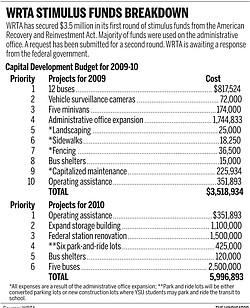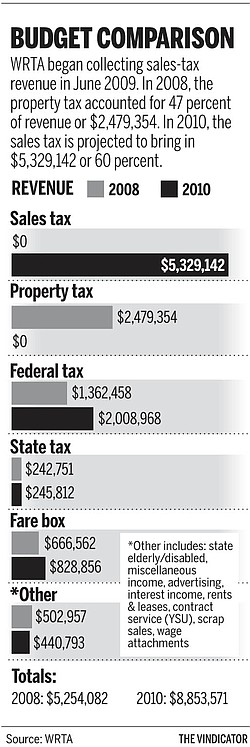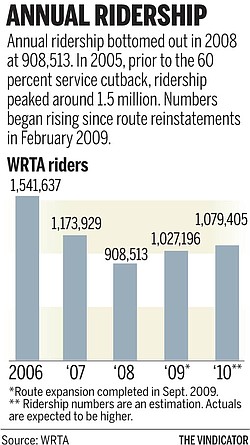With more use, WRTA faces cost hazards
By Doug Livingston
TheNewsOutlet.org
YOUNGSTOWN
The Western Reserve Transit Authority’s September expansion to a countywide service plan is paying off in ridership increases.
The authority originally estimated the expansion would bring an additional 50,000 riders for 2010. In the first five months of expanded service, however, 100,000 additional riders have taken the bus compared with the same period in 2009.
But the expansion brings concerns, said WRTA President Michael Bosela.
The new service means increased costs amid fluctuating sales-tax revenue.
Officials are pondering how to control costs and stay within their new budget.
Historically, the Mahoning transit system is no stranger to funding problems.
WRTA’s expenditures in 2006 were $1.5 million more than its revenue. The transit authority cut service 60 percent to compensate for this deficit.
Passage of a 0.25-percent sales tax in November 2008 has provided more than $3 million in additional revenue compared to what property taxes generated. Services have expanded to include the connecting current routes, the creation of other routes and an extensive curb-to-curb service.
The transition was completed in September.
“We’ve been poor for a long time,” said James Ferraro, transit authority executive director. “We think we’re kind of good at it. But, again, we haven’t been rich at all, so we’re not so good at that. We’re going to have to keep a keen eye on where we’re headed.”
Ferraro says he is aware the taxpayers who voted for the sales tax will be watching how their money is spent.
The expanded service could be cut back or altered after a June assessment. Ferraro said that if routes such as Boardman, Struthers and Cornersburg do not produce higher numbers, they will face extinction or experience a lower frequency of buses.
“We’ve been talking to elected officials in a number of those communities about, basically, use it or lose it,” Ferraro said.
Ridership bottomed out in 2008 at about 900,000 riders annually. In 2005, before the 60-percent service cutback, ridership peaked around 1.55 million. Ridership is on the rise again since route reinstatements began in February 2009.
The operating budget always is a tight issue.
The sales tax and stimulus funds could not have come at a more crucial time.
Operational assistance has been pulled from the first stimulus package in the amount of $352,000. An additional $352,000 is earmarked in a request for a second round of stimulus. These funds assist in paying for added expenses incurred by the service expansion, including extra fuel and maintenance costs.
The stimulus money is used as an “aid,” Secretary Treasurer Marianne Vaughn said.
Bus maintenance is expected to increase by $1.2 million annually under the expanded service.
Like any other transit system, federal and state funding must be secured in order to operate. Nearly $2 million is collected annually — $1.7 million from the federal government and $300,000 from the state.
The sales tax is supporting the countywide expansion. The tax, however, is subject to fluctuate with the local economy.
WRTA budgeted $4.5 million in revenue from the sales tax last year. It collected $4.2 million. The authority budgeted $5.3 million for 2010.
The NewsOutlet is a joint media venture by student and professional journalists and is a collaboration of Youngstown State University, WYSU Radio and The Vindicator.
 43
43



